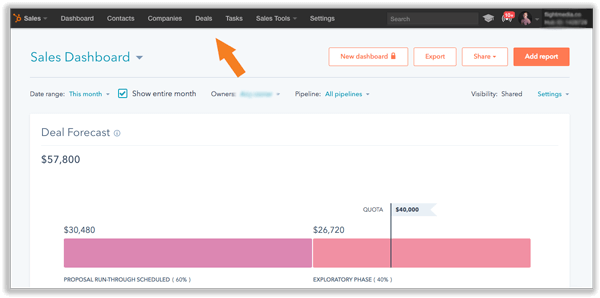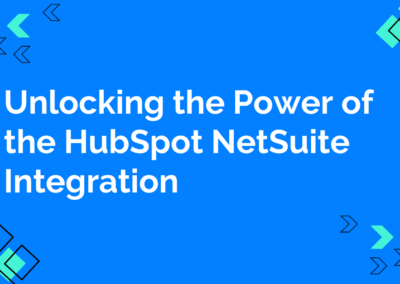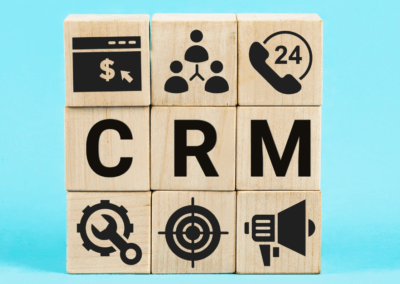As we discussed before, in our blog post, “HubSpot vs. Pipedrive: Which CRM is Better for Sales?”, choosing a customer relationship management tool for your B2B company is a big decision. You need to take a lot of factors into account, like the size of your company, what software you want to integrate, and what the main functions of your CRM will be. It’ll help you find new contacts and organize the ones you have, allow you to nurture your leads, and facilitate collaboration between your sales and marketing teams. In other words, you’ll be spending a lot of time with it. With so many options out there, there’s no one-size-fits-all answer to which is best, but we’re going to break down some of the key aspects of two of the most popular CRMs: HubSpot vs. Salesforce.
All about HubSpot
The great thing about HubSpot, especially for a new business, is that there is a free option. While you will probably have to add on some premium sales tools as your company grows and you need change, you have a lot of flexibility to purchase just the ones you need. HubSpot’s CRM also gives you the option to have as many users on it as you want, enabling more collaboration between your sales and marketing teams. The free CRM option offers contact management, deal and task management, and integrations with social media and email that allows you to track your interactions with leads.
The HubSpot CRM wasn’t created to compete with Salesforce. According to Impact, HubSpot’s CRM is ideal for companies that are new to customer relationship management systems, that are looking to improve their organization and efficiency.
If you’re already using the countless tools that HubSpot offers new businesses, it would make sense to want all of your information in a single place. After all, HubSpot does offer tools for social media marketing, web and social analytics, content management, landing pages, and search engine optimization, as well as videos, to teach you how to use all of them.

About Salesforce
Salesforce is one of the original CRMs, founded in 1999. Currently, Salesforce is the No. 1 CRM, dominating 30.27% of the market share, with over 45,000 domains under its belt. Known for offering just about everything you might need in a CRM and name recognition, it’s typically the first CRM that new business owners look into.
It’s also not surprising that that convenience isn’t free. Convenience typically costs a pretty penny — like that last time you ordered an Uber when you really could have taken the train, or that Doordash you ordered when you had a fridge full of ingredients to make dinner, Salesforce is no different. For many up-and-coming B2B companies, Salesforce’s pricing is just not in their budget. There’s no free plan, and though pricing starts at a mere $25 a month, most companies need more than the $25 plan offers. PieSync suggests that the average user needs to spend about $150 on Salesforce to get all of the functionality they’ll need.
Interface
You know how some people live and die by Apple products, while others prefer the look and feel of a PC? Neither one is notably better (despite what people on either side of the fence will try to convince you on), but it all comes down to the type of interface you prefer.
HubSpot is known for having a clean, simple, user-friendly look to it. After all, its CRM was specifically created for beginners. You’re able to clearly see everything that HubSpot has to offer, on an intuitive dashboard. We mentioned before how Salesforce provides more than most marketers will ever need, and you can tell that by looking at the dash. It’s pretty clunky, with a lot of information right there on the screen, but you still need to click around and do deep dives to find all of the information that you’re looking for. Flight Media took screenshots of both for you to compare:
Integration
Like in our previous post comparing HubSpot and Pipedrive, it all comes down to integration! While your CRM will be able to do a lot, it won’t do absolutely everything a growing business needs it to (Nope, not even Salesforce). This is where integration comes in. While some CRM systems have barriers to integration, neither HubSpot or Salesforce do. Salesforce ultimately allows for integration among more programs than HubSpot does. Still, HubSpot is sure to offer extensions for some of the most prominent programs you’ll be using, like Microsoft Office and Google Suite.
What if you already have a CRM, though, and are looking around for other options? Well, HubSpot might be the pick for you. Not only can you simultaneously use both CRMs, but you can eventually integrate your data into HubSpot. This is also handy when you have clients working along with you who use a different in-house CRM — even if that other CRM is Salesforce.
Depending on the size of your business and how in-depth you want your reporting to be, there are certainly pros and cons to both HubSpot and Salesforce. If you’re just starting, though, HubSpot’s user-friendly interface and wallet-friendly pricing might be the way to go.






